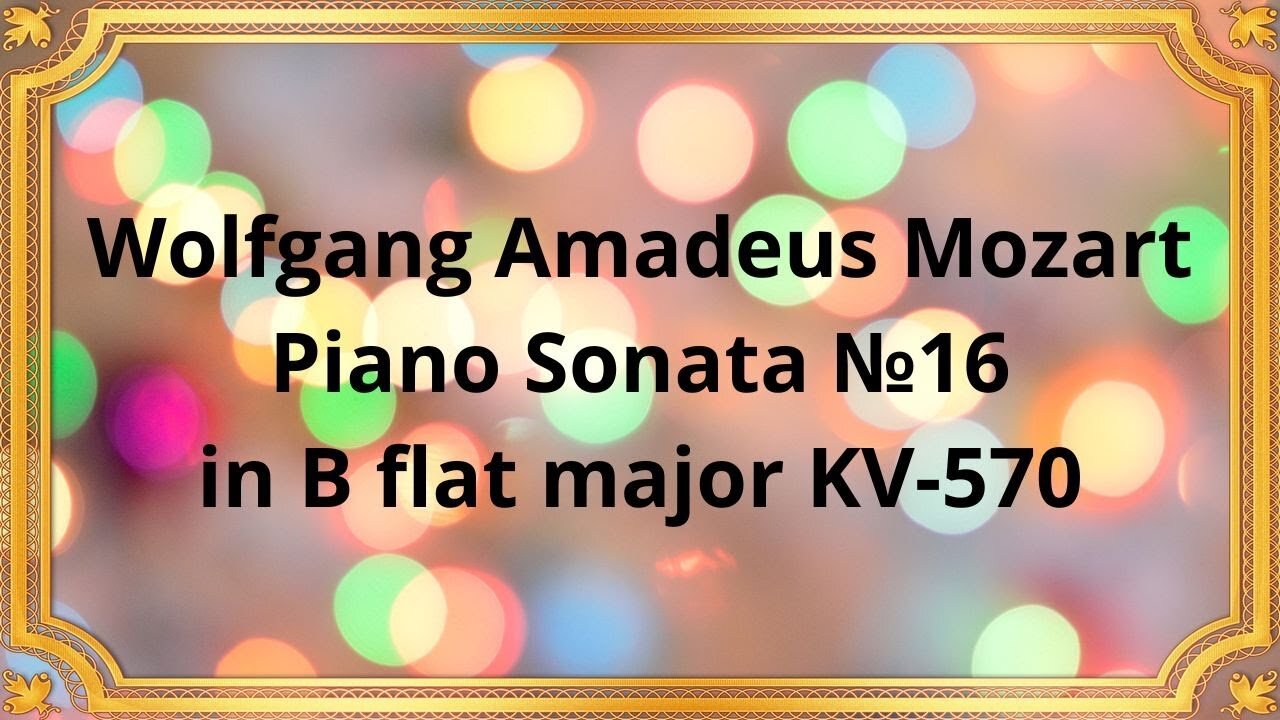Premium Only Content

Wolfgang Amadeus Mozart Piano Sonata №16 in B flat major KV-570
#Mozart #MozartPianoSonata #ClassicalComposer #MozartKV570 #PianoMusic #MusicTheory #MusicAppreciation #BaroqueMusic #MozartMastery #MusicHistory #18thCenturyMusic #PianoVirtuoso
Publication date 1951
Jacqueline Blancard, piano
Wolfgang Amadeus Mozart, a prodigious composer of the Classical era, left an enduring legacy of musical genius. Among his vast body of work, the Piano Sonata No. 16 in B flat major KV-570 stands as a testament to his exceptional talent and compositional prowess.
Composed in 1789, at the height of Mozart's career, the Piano Sonata No. 16 in B flat major KV-570 showcases the composer's maturity and artistic refinement. This period marked a transition from Mozart's earlier works characterized by exuberance and virtuosity to a more introspective and profound style. The sonata reflects the influence of the Classical period, with its emphasis on balanced structures and elegant melodies.
The sonata follows the traditional three-movement structure, consisting of an Allegro, Adagio, and a spirited Rondo. The opening Allegro presents a spirited and playful theme, showcasing Mozart's signature charm and melodic inventiveness. The Adagio, in contrast, offers a serene and introspective interlude, with delicate ornamentation and expressive harmonies. The final Rondo brings the composition to a lively and jubilant conclusion, characterized by its infectious rhythm and virtuosic passages.
Mozart's Piano Sonata No. 16 in B flat major KV-570 is renowned for its harmonic richness and exploratory nature. The opening movement showcases Mozart's skillful modulation, seamlessly transitioning between keys and creating a sense of tension and release. The Adagio, with its tender and poignant melodies, explores chromatic harmonies, adding depth and emotional intensity. The Rondo, on the other hand, dazzles with its harmonic surprises and intricate variations, displaying Mozart's mastery of counterpoint and harmonic invention.
Within this sonata, Mozart demonstrates his ability to infuse emotion and expression into his compositions. The Allegro brims with joy and exuberance, while the Adagio evokes a sense of introspection and melancholy. The Rondo, with its lively tempo and virtuosic passages, showcases Mozart's technical brilliance and playful spirit. Each movement presents a unique emotional landscape, inviting the listener on a journey of varied moods and sentiments.
Mozart's Piano Sonata No. 16 in B flat major KV-570 continues to captivate audiences and musicians alike, centuries after its composition. Its harmonically adventurous nature and emotional depth have solidified its place among Mozart's most celebrated works. The sonata's influence can be seen in the works of later composers, who drew inspiration from Mozart's innovative approach to form, harmony, and expression.
Conclusion:
Wolfgang Amadeus Mozart's Piano Sonata No. 16 in B flat major KV-570 stands as a testament to the composer's enduring genius and musical innovation. Through its harmonic exploration, expressive nuances, and elegant structure, this timeless composition leaves a lasting impression on listeners. As we delve into the intricate depths of this remarkable piece, we gain a deeper appreciation for Mozart's extraordinary talent and his invaluable contribution to the world of classical music.
You have the opportunity to support the channel:
https://destream.net/live/RadSiarAl/donate
https://www.buymeacoffee.com/6355radsiaral
-
 34:26
34:26
Classical music_Music Inspiration
1 month agoAram Khachaturian Concerto for Violin and Orchestra
912 -
 54:18
54:18
Candace Show Podcast
10 hours agoHarvey Speaks: Jessica Mann & The Five Year Affair | Ep 3
170K74 -
 56:53
56:53
Grant Stinchfield
8 hours ago $6.90 earnedFreeze Spending & Kick the Can Down the Road... Why Republicans Should do Just That!
88.6K15 -
 56:48
56:48
VSiNLive
9 hours agoFollow the Money with Mitch Moss & Pauly Howard | Hour 1
70.5K1 -
 3:28:27
3:28:27
Barry Cunningham
10 hours agoTRUMP DAILY BRIEFING: INTERNET UNDER ATTACK! X & RUMBLE DOWN! EXECUTIVE ORDER SIGNING!
91.1K56 -
 5:53:56
5:53:56
Scammer Payback
13 hours agoCalling Scammers Live
78.9K5 -
 1:36:15
1:36:15
In The Litter Box w/ Jewels & Catturd
1 day agoABOLISH NGOs | In the Litter Box w/ Jewels & Catturd – Ep. 758 – 3/10/2025
98.3K63 -
 2:04:36
2:04:36
Film Threat
1 day agoVERSUS: DAREDEVIL: BORN AGAIN + MICKEY 17 + THE STATE OF SCI-FI | Film Threat Versus
44.6K1 -
 1:21:46
1:21:46
The HotSeat
10 hours agoIt's A Trap America! Do Not Fall For It!
33.3K19 -
 1:26:22
1:26:22
The Quartering
12 hours agoTrump In Dubai, Democrats BUSTED Funding Attacks On Tesla, DOGE Covid BOMBSHELL & Bernie Sanders
92.1K83